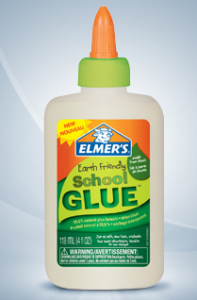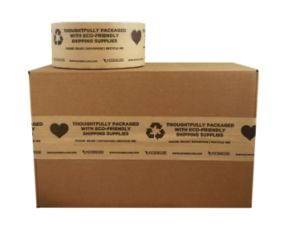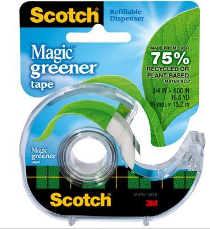Maybe you are back to school shopping or just ran out of tape, whatever the case may be you are looking for environmentally friendly adhesive.
Well, you’ve come to the right place! I scoured the internet looking for quality eco-friendly adhesive, and guess what? I found some!
Spoiler Alert: I was not entirely enthused with what I found as far as selection goes for environmentally friendly glue and tape as you will soon find out.
Please humor me while I attempt to explain ordinary, non-ecofriendly glue so we have a baseline to start with.
What is glue made from?
For simplicity’s sake, I am going to be referring to synthetic glues only. I am not going to get into the ‘natural’ glues made from animal products, such as horses. (If you would like to know more about natural glue, let me know in the comments below).
That being said, synthetic glue is made from a bunch of chemical reactions. To put it as simply as possible, the base ingredient is vinyl acetate which goes through a chemical reaction to form polyvinly acetate (PVA). The PVA is then emulsified in a solution to create the correct texture of the glue being made.
PVA is the base ingredient for most types of synthetic glues. Other base compounds include epoxy and polyurethane. Most are derived from crude oil.
Is glue environmentally friendly?
Again, I am going to be referring to PVA based glue when I answer this question because it is the most common base for glues currently, including the almighty Elmer’s glue.
Who hasn’t eaten, I mean used Elmer’s glue growing up, am I right?
Polyvinyl acetate glue is best known as: wood glue, carpenter’s glue, school glue, and Elmer’s glue to name a few examples.
Honestly, before researching adhesives, I thought the answer to the above question would be a resounding NO! But upon further research, I don’t believe the answer is that cut and dry.
PVA is made from refined oil and other chemicals are added to it to get the desired consistency of whatever glue product it is apart of. So there’s that. Not an environmental all star, I know, but let’s face it, almost everything we use in this world today is somehow derived from crude oil.
However, a surprise to me was that there is no evidence that glue products are found in the environment. In fact, a number of microorganisms like algae, yeast, lichens, and bacteria actually degrade polyvinyl acetate.
So, is glue environmentally friendly? Well, not really. While it’s not the worst thing for the envionment. Is it the best? No, ideally glue would not be made from crude oil products but the fact that its biproducts are not detected in the environment is a good thing.
Is adhesive biodegradable?
While some adhesive products are made from natural ingredients, often there are chemicals added to make the desired texture, and to increase the shelf life of the glue (among other uses). This means that more often than not, adhesives are NOT biodegradable.
How do you make glue eco-friendly?
Here’s the hard truth: glue is not eco-friendly. I searched the internet up and down looking for truly eco-friendly glue (no petroleum products, water based, low or no VOC, recyclable packaging, etc). A perfectly eco-friendly glue just doesn’t exist in todays market.
That being said, there are some glues that come close to being environmentally friendly.
Eco-friendly School Glue
Unfortunately, it’s pretty slim pickins when it comes to eco-friendly school glue. The closest to environmentally friendly school glue is Elmer’s glue.
Elmer’s Earth Friendly School Glue is a good choice for your youngins working on their school project or just have a need to glue stuff together.
Elmer’s Earth Friendly School Glue
- 99.6% natural glue formula (made from plants)
- Bottle is made from 25% post-consumer recycled plastic
- Label is made from 20% recycled paper
- Label is printed with soy inks and adhered with a natural rubber adhesive
Ecofriendly glue sticks
Unsurprisingly, there are not many options for ecofriendly glue sticks. I was able to round up a couple of enviromentally friendly glue sticks, but let me tell you, it wasn’t that easy!
The UHU ReNATURE
- Formula with 98% natural ingredients
- Packaging for blister variants with over 80% recycled content and completely PVC free
- 100% recyclable container
Coccoina Glue Stick
- Made with almond oil and potato starch
- Non-toxic
- Acid free
Ecofriendly wood glue
For the life of me, I could not find any eco-friendly wood glue. Sorry. I wish I had better news. If anyone reading this knows of any enviornmentally friendly wood glue, please let me know in the comments so I can update this section with useful information. Thanks!
Biodegradable hot glue sticks
Glue sticks made with ethylene vinyl acetate (EVA) are as ecofriendly as you’re going to get when it comes to hot glue sticks.
Again, take this information with a grain of salt. Let’s not kid ourselves here. EVA is still a plastic product, it just happens to be less worse than others.
Most hot glue sticks on the market today are made from EVA, and more and more companies are moving toward earth friendly options, so that’s a good thing I guess.
Pros of EVA hot glue sticks:
- Water based
- Low VOC
However, are glue sticks biodegradable? No, even ones made from EVA. It is still a plastic polymer and not readily biodegradable.
Ecofriendly industrial glue
When it comes to manufacturing products, LD Davis seems to have a leg up when it comes to environmentally friendly industrial glue.
If you are a manufacturer and looking to change the adhesive you are using to an ecofriendly industrial adhesive, check out their website here.
Their products include protein based adhesives, however many contain gelatin so if you’re a vegan manufacturer you might be out of luck with LD Davis, unfortunately.
On the plus side, LD Davis claims their protein based adhesives are completely biodegradable. In any case, there’s not much choice as far as environmentally friendly industrial glue suppliers are concerened, so give their website a peruse if you’re interested.
Homemade glue
Maybe what you have read about glue so far has not sat well with you. I know that I was surprised by the lack of environmentally friendly options available.
Well, you can know EXACTLY what is in your glue when you make it at home.
SnappyLiving has compiled a list of 11 eco-friendly homemade glue recipes that you could make with ingredients you have in your pantry right now. Check out their article here.
Eco friendly tape
Yes! There is such a thing as eco-friendly tape. HOORAY! 
Packing Tape
Water Activated Carton Sealing Tape from EcoEnclose
- Cellophane backing with natural rubber adhesive
- Entirely plant derived
- Renewable
- Naturally biodegradable
- Best for high-volume applications
Pressure activated Carton Sealing Tape from EcoEnclose
- Same benefits as above but best suited for lower volume applications and lighter packages
Tesapack eco & strong from Tesa
- Made from 100% recycled plastic
- Core made from 100% recycled cardboard
- Label made from paper
- Solvent free adhesive
Scotch Tape
Yes! A go-to in most families in a paper ripping crisis, Scotch Tape is now available in an earth friendly version.
Scotch Magic Greener Tape 
- Made from over 65% recycled or plant based material
- Refillable dispenser made from over 75% renewable or recycled materials
- Works just as well as the original Scotch Tape
Best Practices for choosing environmentally friendly adhesive
Since, it’s not entirely cut and dry as to what adhesives are eco-friendly and which ones are not, I have put together a few things to keep in mind when choosing environmentally friendly adhesive.
Here are some simple guidelines to follow when choosing any type of earth friendly adhesive:
- Recyclable packaging
- Recyclable dispenser
- low or no VOC
- No solvents (water or plant based)
I hope this article helped you out a bit on your quest for environmentally friendly adhesive. Honestly, I was pretty disapointed with the lack of options available.
The silver lining is that big companies are starting to produce eco-friendly adhesives, so hopefully other companies will follow suit and make them more readily available for the general public.
Patience is a virtue.
As always, leave any comments and questions below. Have you made your own glue before?
Cheers, and have an awesome day!






This article was extremely helpful. Thank you so much for compiling this information. Of course we continue to fact-check on a daily basis because the target keeps moving. I make all natural products for sale and packaging is quite the challenge. So helpful! Thanks again
Thank you so much for your kind words!
Hi, I bought I – GLU by Creatively International Ltd, DYS 1UF (UK based). It says it is eco-friendly. Dries virtually clear, is odourless, will glue paper, card, woods, foils etc. Ideal for educational use but I can’t find a list of what’s in it so hopefully you will have more luck?
Kathy, cheers for writing this! Some good time and research has been put in, you can tell. Nice one. 😀
Thank you so much! It’s positive, encouraging comments like this that keep me going! Thanks for taking the time to comment.
Caesin based wood adhesives are widely available in europe and made from Milk protine. Which asside from the negative impact of dairy farming makes them a natural product.
Thanks for the info! I appreciate any additional information that can help consumers make more eco-friendly choices.
Thanks for the column. I would propose that even though there is no truly green wood glue, there is also no truly green vehicle, container, agricultural practice etc. By definition wood glue is used to build or repair a product that is made from a renewable resource, and thus worthy of some credit. I work at a building supply, I struggle with the amount of wafer boards, particle boards, MDF’s and other products that we sell that are full of adhesives, but I also remember a company rep from a sawmill who told me that because of these products and other technologies that they are selling over 50% product per tree than they were in the 1970’s.
This is true. All we can do is make the best choice and as long as more and more people are choosing a more eco-friendly option, the better the earth will be in the long run. Thanks for your comment!
The wood products are still lesser environmental friendly concerning glue if the connections have to be water-proof.
Some connections like veneer are done with kaurit glue which was known to include formaldehyde, I’m not sure if that ingredient is still used as restrictions by law should prohibit or limit it (at least in Europe) for indoor-products.
Sustainable glues like casein-glues have been replaced because they’ve been degraded by bacteria, at least sometimes. So for wooden elements with static function it’s probably a bad choice especially when liability rules are part of related contracts.
Perhaps the page https://en.wikipedia.org/wiki/Wood_glue is helpful, but it’s linking many other pages, so it takes some time to study all related knowledge.
Infinity Bond’s Infinty HM-Enviromelt-100 a 100% compostable and biodegradable hotmelt adhesive commonly used for bookbinding, packaging, and laminating.
Excellent article, exactly what I was looking for!
Awesome! Glad you liked it!
Thank you for sharing this information, a great article.
Thanks so much!
If you don’t need a very strong glue and you want something that is one hundred percent non toxic for the environment you might want to look into methylcellulose.
Methylcellulose comes in powder form and needs to be mixed with some precision. For a liter and a half of glue, I boil 350gm of distilled water, add it to a 1.6 liter container, then add three tablespoons of the powder and mix it in with an electric mixer. Once it is well dispersed in the water, even if not totally disolved, I add cold distilled water for the rest. If you refrigerate it overnight, it will come out perfectly transparent, smooth and ready to use.
The distilled water insures that no bacteria will grow and spoil the glue if you are not using it immediately or all at once.
There are a few different grades of quality — best to look for archival quality.
Great article and also comment about methylcellulose which is used in eco-friendly paints and plasters. I wonder too about seaweed (alginate powder) which the Japanese use in plaster. I tried to make my own seaweed glue from the plants with not much success but there are a lot of industry applications. Maybe it’s not strong enough on it’s own and only binds with other things?
Thanks so much for the research. I am a carpenter trying to be as eco friendly as possible but I am frustrated with the lack of green products. Can I use this website as a reference for an Instagram video. I will be sure to give you a shoutout if you want.
Sure!
they still make old style animal glue for wood glue purposes, know as hide glue
whether or not you think boiling an animal is environmentally friendly is up to you
but its certainly carbon neutral
Thank you so much for this article! It is very helpful. Can I ask why is ethylene vinyl acetate (EVA) considered environmentally friendly? It it simply because it does not contain BPA?
Try Tinyland for eco friendly wood glue.
Have you found it to be very strong?
Really helpful, I have shared on social, hope that’s ok…we need more people to just stop and think about these things don’t we!